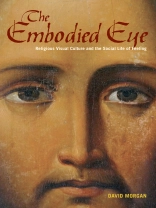David Morgan builds on his previous groundbreaking work to offer this new, systematically integrated theory of the study of religion as visual culture. Providing key tools for scholars across disciplines studying the materiality of religions, Morgan gives an accessibly written theoretical overview including case studies of the ways seeing is related to touching, hearing, feeling, and such ephemeral experiences as dreams, imagination, and visions. The case studies explore both the high and low of religious visual culture: Catholic traditions of the erotic Sacred Heart of Jesus, the unrecognizability of the Virgin in the Fatima apparitions, the prehistory of Warner Sallman’s face of Jesus, and more. Basing the study of religious images and visual practices in the relationship between seeing and the senses, Morgan argues against reductionist models of ‘the gaze, ‘ demonstrating that vision is not something that occurs in abstraction, but is a fundamental way of embodying the human self.
Tabella dei contenuti
List of Illustrations
Preface
Acknowledgments
Part One. Culture’s Two Bodies
1. Vision and Embodiment
2. The Body in Question
3. Ways of Seeing
4. Icon and Interface
Part Two. The Senses of Belief
5. The Matter of the Heart: Touching and Seeing
6. The Look of Sympathy: Feeling and Seeing
7. The Enchantment of Media: Hearing and Seeing
8. At the Cusp of Invisibility: Visions, Dreams, and Images
Notes
Select Bibliography
Index
Circa l’autore
David Morgan is Professor of Religion at Duke University. He is the author of several books, including The Sacred Gaze: Religious Visual Culture in Theory and Practice and Visual Piety (both from UC Press).












